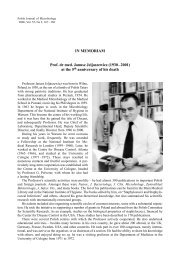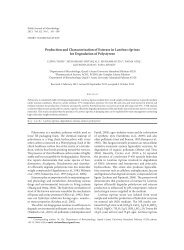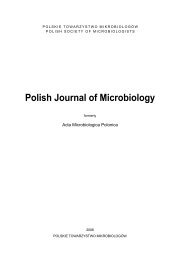No 3 - Polish Journal of Microbiology
No 3 - Polish Journal of Microbiology
No 3 - Polish Journal of Microbiology
You also want an ePaper? Increase the reach of your titles
YUMPU automatically turns print PDFs into web optimized ePapers that Google loves.
212<br />
optimum temperature was 50°C. When the temperature<br />
reached 60°C, relative xylanase activity retained<br />
was about 64.75% under the assay conditions used.<br />
The optimum temperature for xylanases from fungal<br />
sources has been found to be similar or slightly higher.<br />
Penicillium citrinum (Tanaka et al., 2005), Penicillium<br />
sp. AH-30 (Li et al., 2007), Aspergillus sydowii SBS 45<br />
(Nair et al., 2008) and Aspergillus niveus RS2 (Sudan<br />
and Bajaj, 2007) presented xylanase with maximum<br />
activities at 50°C. Penicillium purpurogenum (Belancic<br />
et al., 1995), Aspergillus orysae (Kitamoto et al., 1999)<br />
and Aspergillus niger (Coral et al., 2002) presented xylanase<br />
with maximum activities at 60°C.<br />
The present study demonstrated that significant<br />
improvement <strong>of</strong> xylanase production by F. solani SYRN7<br />
isolate could be obtained by selective use <strong>of</strong> nutrients<br />
and growth conditions. Since xylan is an expensive substrate<br />
for commercial scale xylanase production, the<br />
possibility <strong>of</strong> using wheat bran for xylanase production<br />
was investigated. Wheat bran (5% by mass per volume)<br />
could be used as a less expensive substrate for efficient<br />
xylanase production (1465.8 U/g). This observation is<br />
interesting due to the low cost <strong>of</strong> this carbon source.<br />
The F. solani SYRN7 isolate proved to be a promising<br />
microorganism for xylanase production.<br />
Acknowledgements<br />
The authors thank the director General <strong>of</strong> AECS and the Head<br />
<strong>of</strong> the Molecular Biology and Biotechnology department for their<br />
continuous support throughout this work. Thanks also extended to<br />
dr. A. Aldaoude for critical reading <strong>of</strong> the manuscript.<br />
Literature<br />
Alazem M. 2007. Characterization <strong>of</strong> Syrian Fusarium species by<br />
cultural characteristics and aggressiveness. Thesis, University <strong>of</strong><br />
damascus, Faculty <strong>of</strong> Agriculture. pp. 72.<br />
Anon. 1996. Statview 4.5. USA: Abacus Concepts Corporation.<br />
Arabi M.I.E., M. Jawhar and Y. Bakri. 2001. Effect <strong>of</strong> additional<br />
carbon sources and moisture level on xylanase production by<br />
Cochliobolus sativus in solid fermentation. <strong>Microbiology</strong> 80: 1–4.<br />
Bailey M.J., P. Baily and R. Poutanen. 1992. Interlaboratory testing<br />
<strong>of</strong> methods for assay <strong>of</strong> xylanase activity. J. Biotechnol. 23: 257–270.<br />
Bakri Y., P. Jacques and P. Thonart. 2003. xylanase production<br />
by Penicillium canescens 10–10c in solid-state fermentation. Appl.<br />
Biochem. Biotech. 108: 737–748.<br />
Belancic A., J. Scarpa, A. Peirano, R. Diaz, J. Steiner and<br />
J. Eyzaguirre. 1995. Penicillium purpurogenum produces several<br />
xylanase: Purification and properties <strong>of</strong> two <strong>of</strong> the enzymes. J. Biotechnol.<br />
41: 71–79.<br />
Chirstakopoullos P., D. Mamma, W. Nerinckxw, D. Kekos and<br />
B. Macris. 1999. Production and partial characterization <strong>of</strong> xylanase<br />
from Fusarium oxysporum. Bioresour. Technol. 58: 115–119.<br />
Coral G., B. Arikan, M.N. Ünaldi and H. Korkmaz-Güvenmez.<br />
2002. Some properties <strong>of</strong> thermostable xylanase from an Aspergillus<br />
niger strain. Ann. Microbiol. 52: 299–306.<br />
Domsch K.H., W. Gams and T. H. Anderson. 1980. Compendium<br />
<strong>of</strong> soil fungi. Academic Press, London.<br />
Guimaraes L.H.S., P.S. <strong>No</strong>gueira, M. Michelin, A.C.S. Rizzatti,<br />
V.C. Sandrim, F.F. Zanoela, A.C.M.M. Aquino, A.B. Junior and<br />
M.L.T.M. Polizeli. 2006. Screening <strong>of</strong> filamentous fungi for produc-<br />
Arabi M.I.E. et al. 3<br />
tion <strong>of</strong> enzymes <strong>of</strong> biotechnological interest. Brazil. J. Microbiol.<br />
37: 474–480.<br />
Haltrich D., B. Nidetzky, K.D. Kulbe, W. Steiner and S. Zupaneie.<br />
1996. Production <strong>of</strong> fungal xylanases. Biores. Technol. 58: 137–161.<br />
Kang S.W., Y.S. Park, J.S. Lee, S.I. Hong and S.W. Kim. 2004. Production<br />
<strong>of</strong> cellulose and hemicellulases by Aspergillus niger KK2<br />
from lignocellulosic biomass. Bioresour. Technol. 91: 153–156.<br />
Kiprop E. K., J.P. Baudoin, A.W. Mwangómbe, P.M. Kimani,<br />
G. Mergeai and A. Maquet. 2002. Characterization <strong>of</strong> Kenyan<br />
isolates <strong>of</strong> Fusarium udum from Pigeonpea [Cajanus cajan (L.)<br />
Millsp.] by cultural characteristics, aggressiveness and AFLP analysis.<br />
J. Phyto pathol. 150: 517–527.<br />
Kitamoto N., S. Yoshino, K. Ohmiya and N. Tsukagoshi. 1999.<br />
Purification and characterization <strong>of</strong> overexpressed Aspergillus<br />
oryzae xylanase xynF1. Biosc. Biotechnol. Biochem. 63: 1791–1794.<br />
Khan A., I. Ul-Haq, W.A. Butt and Ali S. 2003. Isolation and<br />
screening <strong>of</strong> Aspergillus isolates for xylanase biosynthesis. Biotech.<br />
2: 185–190.<br />
Khanna P., S.S. Sundari and N.J Kumar. 1995. Production, isolation<br />
and partial purification <strong>of</strong> xylanase from an Aspergillus sp.<br />
World J. Microbiol. Biotechnol. 11: 242–243.<br />
Kulkarni N., A. Shendye and M. Rao. 1999. Molecular and biotechnological<br />
aspects <strong>of</strong> xylanases. FEMS Microbiol. Rev. 23: 411–456.<br />
Li Y., Z. Liu, F. Cui and Y.X.H. Zhao. 2007. Production <strong>of</strong> xylanase<br />
from a newly isolated Penicillium sp. ZH-30. World J. Microbiol.<br />
Biotechnol. 23; 837–843.<br />
Medel, P., F. Baucells, M.I. Gracia, C. Blas and G.G. Mateos. 2002.<br />
Processing <strong>of</strong> barley and enzyme supplementation in diets for young<br />
pigs. Animal Feed Sci. Technol. 95: 113–122.<br />
Miller G.L. 1959. Use <strong>of</strong> dinitrosalicylic acid reagent for determination<br />
<strong>of</strong> reducing sugars. Ann. Chem. 31: 426–428.<br />
Nair S.G., R. Sindhu and S. Shashidhar. 2008. Purification and biochemical<br />
characterization <strong>of</strong> two xylanases from Aspergillus sydowii<br />
SBS 45. Appl. Biochem. Biotechnol. 149: 229–243.<br />
Nelson P.E., T.A. Toussoun and W.F.O. Marasas. 1983. Fusarium<br />
Species: An Illustrated Manual for Identification. The Pennsylvania<br />
State Univ. Press, University Park.<br />
Nwanma B., N. Onyike and P. E. Nelson. 1993. The distribution <strong>of</strong><br />
Fusarium species in soils planted to millet and sorghum in Lesotho,<br />
Nigeria and Zimbabwe. Mycopathologia 121: 105–114.<br />
Pandey A. 1994. Solid state fermentation: an overview, In: Solid<br />
state fermentation. Ashok Pandey, Wiley Eastern, New deli.<br />
Poorna C.A. and P. Prema. 2007. Production <strong>of</strong> cellulose-free<br />
endoxylanase from novel alkalophilic thermotolerent Bacillus pumilus<br />
by solid-state fermentation and its application in waste paper<br />
recycling. Bioresour Technol. 98: 485–490.<br />
Romanowska A., K.P. Janowska and S. Bielecki. 2003. The application<br />
<strong>of</strong> fungal endoxylanase in bread-making. Commun. Agric. Appl.<br />
Biol. Sci. 68: 317–320.<br />
Saha B.C. 2003. Hemicellulose bioconversion. J. Ind. Microbiol.<br />
Biotechnol. 30: 279–291.<br />
Sudan R. and B.K. Bajaj. 2007. Production and biochemical characterization<br />
<strong>of</strong> xylanase from an alkalitolerant novel species Aspergillus<br />
niveus RS2. World J. Microbiol. Biotechnol. 23: 491–500.<br />
Sunna A. and G. Antranikian. 1997. xylanolytic enzymes from<br />
fungi and bacteria. Crit. Rev. Biotechnol. 17: 39–67.<br />
Tanaka H., N. Toshihide., H. Sachio and O. Kazuyoshi. 2005. Purification<br />
and properties <strong>of</strong> an extracellular endo-1,4-β-xylanase from<br />
Penicillium citrinum and characterization <strong>of</strong> the encoding gene.<br />
<strong>Journal</strong> <strong>of</strong> Bioscience and Bioengineering. 100: 623–630.<br />
Weiland P. 1988. Principles <strong>of</strong> solid state fermentation. In: F. Zadrazil,<br />
P. Reiniger (Eds), Treatment <strong>of</strong> lignocellulosics with white rot fungi,<br />
Elsevier, London, pp. 64–76.<br />
Wong K.K.Y., C.S. James and S.H. Campion. 2002. xylanase pre<br />
and post-treatments <strong>of</strong> bleached pulps decrease absorption coefficient.<br />
J. Pulp pap. Sci. 26: 377–383.






